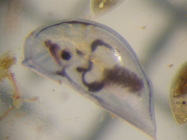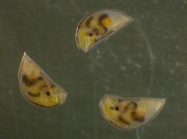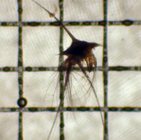RAS taxon details
Lepas Linnaeus, 1758
- Subgenus Lepas (Lepas) Linnaeus, 1758
- Species Lepas fascicularis Ellis & Solander, 1786 accepted as Dosima fascicularis (Ellis & Solander, 1786) (generic reassignment)
- Species Lepas anatifera Linnaeus, 1758 represented as Lepas (Lepas) anatifera Linnaeus, 1758
- Species Lepas australis Darwin, 1851 represented as Lepas (Lepas) australis Darwin, 1851
marine
Linnaeus, C. (1758). Systema Naturae per regna tria naturae, secundum classes, ordines, genera, species, cum characteribus, differentiis, synonymis, locis. [The system of nature through the three kingdoms of nature, according to classes, orders, genera, species, with characters, differences, synonyms, places.]. <em>Impensis Direct. Laurentii Salvii. Holmiae [Stockholm].</em> 1(10) [iii], 824 p., available online at https://biodiversitylibrary.org/page/726886 [details] Available for editors 
RAS (2025). Lepas Linnaeus, 1758. Accessed at: https://ras.biodiversity.aq/aphia.php?p=taxdetails&id=106087 on 2025-09-12
RAS (Eds.) (2025). Register of Antarctic Species. Lepas Linnaeus, 1758. Accessed at: https://ras.biodiversity.aq/aphia.php/www.pfeil-verlag.de/04biol/www.pfeil-verlag.de/04biol/aphia.php?p=taxdetails&id=106087 on 2025-09-12
Date
action
by
original description
Linnaeus, C. (1758). Systema Naturae per regna tria naturae, secundum classes, ordines, genera, species, cum characteribus, differentiis, synonymis, locis. [The system of nature through the three kingdoms of nature, according to classes, orders, genera, species, with characters, differences, synonyms, places.]. <em>Impensis Direct. Laurentii Salvii. Holmiae [Stockholm].</em> 1(10) [iii], 824 p., available online at https://biodiversitylibrary.org/page/726886 [details] Available for editors 
taxonomy source Chan, B. K. K.; Dreyer, N.; Gale, A. S.; Glenner, H.; Ewers-Saucedo, C.; Pérez-Losada, M.; Kolbasov, G. A.; Crandall, K. A.; Høeg, J. T. (2021). The evolutionary diversity of barnacles, with an updated classification of fossil and living forms. <em>Zoological Journal of the Linnean Society.</em> , available online at https://doi.org/10.1093/zoolinnean/zlaa160 [details]
basis of record Southward, A.J. (2001). Cirripedia - non-parasitic Thoracica, <B><I>in</I></B>: Costello, M.J. <i>et al.</i> (Ed.) (2001). <i>European register of marine species: a check-list of the marine species in Europe and a bibliography of guides to their identification. Collection Patrimoines Naturels,</i> 50: pp. 280-283 (look up in IMIS) [details]
additional source Ren, X. (1989). On a collection of Cirripedia thoracia from Madagascar and adjacent waters. <em>Bull. Mus. Natn. Hist. Nat., Paris.</em> 11(2): 431-468. [details]
additional source Hayward, P.J. & J.S. Ryland (Eds.). (1990). The marine fauna of the British Isles and North-West Europe: 1. Introduction and protozoans to arthropods. <em>Clarendon Press: Oxford, UK.</em> 627 pp. (look up in IMIS) [details] Available for editors
taxonomy source Chan, B. K. K.; Dreyer, N.; Gale, A. S.; Glenner, H.; Ewers-Saucedo, C.; Pérez-Losada, M.; Kolbasov, G. A.; Crandall, K. A.; Høeg, J. T. (2021). The evolutionary diversity of barnacles, with an updated classification of fossil and living forms. <em>Zoological Journal of the Linnean Society.</em> , available online at https://doi.org/10.1093/zoolinnean/zlaa160 [details]
basis of record Southward, A.J. (2001). Cirripedia - non-parasitic Thoracica, <B><I>in</I></B>: Costello, M.J. <i>et al.</i> (Ed.) (2001). <i>European register of marine species: a check-list of the marine species in Europe and a bibliography of guides to their identification. Collection Patrimoines Naturels,</i> 50: pp. 280-283 (look up in IMIS) [details]
additional source Ren, X. (1989). On a collection of Cirripedia thoracia from Madagascar and adjacent waters. <em>Bull. Mus. Natn. Hist. Nat., Paris.</em> 11(2): 431-468. [details]
additional source Hayward, P.J. & J.S. Ryland (Eds.). (1990). The marine fauna of the British Isles and North-West Europe: 1. Introduction and protozoans to arthropods. <em>Clarendon Press: Oxford, UK.</em> 627 pp. (look up in IMIS) [details] Available for editors
 Present
Present  Inaccurate
Inaccurate  Introduced: alien
Introduced: alien  Containing type locality
Containing type locality



